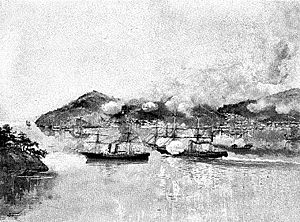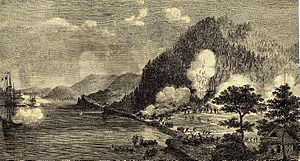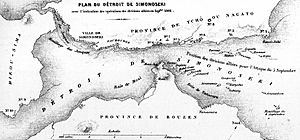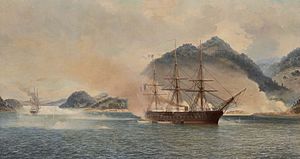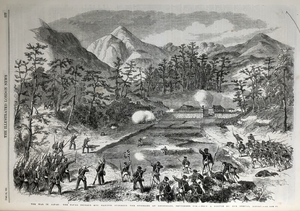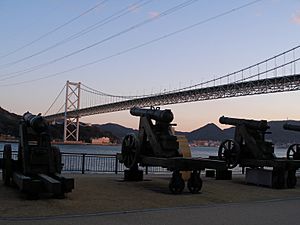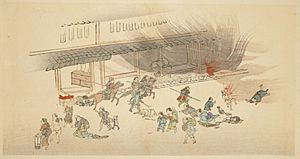Shimonoseki campaign facts for kids
Quick facts for kids Shimonoseki campaign (下関戦争・馬関戦争) |
|||||||
|---|---|---|---|---|---|---|---|
| Part of the Chōshū Rebellion | |||||||
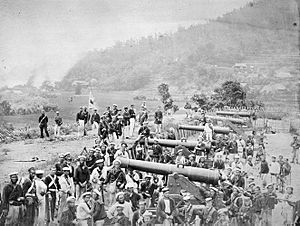 Capture of a Choshu battery at Shimonoseki by British sailors and marines; picture taken by Felice Beato |
|||||||
|
|||||||
| Belligerents | |||||||
| Commanders and leaders | |||||||
|
|||||||
| Strength | |||||||
| Land: 2,000 Sea: 28 warships |
Land: 1,500 100 artillery pieces Sea: 6 warships 40 war-junks |
||||||
| Casualties and losses | |||||||
| 12 killed 50 wounded |
18 killed 29 wounded 2 ships destroyed 1 ship damaged 60 cannons captured |
||||||
The Shimonoseki campaign (also known as the Shimonoseki War) was a series of battles in Japan during 1863 and 1864. These fights were about controlling the Shimonoseki Strait. This important waterway was fought over by ships from Great Britain, France, the Netherlands, and the United States. They were fighting against a Japanese area called Chōshū. The battles happened on and near the coast of Shimonoseki, Japan.
Contents
Why the Shimonoseki Campaign Happened
Even though the Japanese government, called the Tokugawa shogunate, tried to keep peace, many powerful Japanese lords, known as daimyōs, were angry about Japan trading with foreign countries. They wanted to keep Japan closed off. This anger turned into fighting when the Japanese emperor, Emperor Kōmei, ordered all foreigners to be expelled. This order was given in March and April of 1863.
The Chōshū clan, led by their daimyō Mōri Takachika, decided to follow the emperor's order. They began to attack foreign ships without warning. These ships were sailing through the Shimonoseki Strait. This strait is a narrow, important waterway. It connects the Inland Sea with the Sea of Japan.
Foreign leaders knew things were tense in Japan. Robert Pruyn, the U.S. Foreign Minister, and Captain David McDougal of the U.S. Navy, both worried about a possible revolution. McDougal wrote in a letter that many believed Japan was "on the eve of revolution" to get rid of foreigners.
The Cry: "Revere the Emperor and Expel the Barbarians!"
The Chōshū clan had some old cannons. But they also had modern weapons. These included five large Dahlgren guns from the United States. They also had three steam warships built in America. These ships were the Daniel Webster, the Lanrick (or Kosei), and the Lancefield (or Koshin).
The first attack happened on June 25, 1863. The U.S. merchant ship SS Pembroke was anchored near Shimonoseki Strait. Two rebel warships attacked it. The Japanese crew shouted, "Revere the Emperor and expel the barbarians!" (sonnō jōi). The Pembroke managed to escape with only minor damage.
The next day, a French naval ship, the Kien Chan, was also attacked. Japanese cannons fired on it from the cliffs. The Kien Chan was damaged and four crew members were hurt.
On July 11, the Dutch warship Medusa sailed into the strait. Its captain, François de Casembroot, thought Lord Mōri Takachika would not attack. He was wrong. Mōri's forces fired many shells at the Medusa. Nine sailors were killed or wounded. The Medusa fired back and escaped. Soon, the Japanese warlord had fired on ships from most foreign nations in Japan.
On July 16, 1863, the U.S. frigate USS Wyoming entered the strait. Captain McDougal led the ship. It fought the Chōshū fleet for almost two hours. McDougal sank two enemy ships and badly damaged another. About 40 Japanese were hurt. The Wyoming also suffered damage. Four of its crew died, and seven were wounded.
The Campaign Continues
First Battle: July 20, 1863
After the U.S. attack, the French Navy took action on July 20. They wanted revenge for the attack on their merchant ship. The French force included marines and two warships. These were the Tancrède and the Semiramis. About 250 men, led by Captain Benjamin Jaurès, attacked Shimonoseki. They destroyed a small town and at least one cannon position.
The French government was not happy about this attack. They told their representatives in Japan that France had other important military duties. They could not afford a war in Japan. Jaurès, however, was praised by the Japanese government for fighting the anti-foreign forces. He even received a special banner.
Talking for Peace
Meanwhile, the Americans, French, British, and Dutch tried to talk things out. They wanted to reopen the passage to the Inland Sea. Months passed, but the problem continued. By May 1864, some Japanese groups had destroyed a lot of foreign property. This included homes, churches, and ships. Even the U.S. Legation in Edo was destroyed.
Throughout 1864, the Shimonoseki Strait stayed closed. Threats of war grew, and talks were stuck. The British Minister to Japan, Sir Rutherford Alcock, spoke with the American and Dutch ministers. They discussed a joint military attack against Mōri.
They started preparing a combined show of force. Fifteen British warships and four Dutch ships gathered. A British army regiment from Hong Kong joined them. The French had fewer ships because most of their forces were in Mexico.
The U.S. was fighting its own Civil War. So, it only offered diplomatic and small military support. Mōri kept delaying talks. The foreign powers decided it was time for action.
In July 1864, the rebel forces attacked the U.S. steamer Monitor. This happened even after a British group warned Mōri. They threatened military force if the strait was not opened.
Final Battle: September 5–6, 1864
On August 17, 1864, a large fleet left Yokohama. It had nine British, four Dutch, and three French warships. There were also 2,000 soldiers, marines, and sailors. All were under the command of Admiral Sir Augustus Leopold Kuper of the Royal Navy. Their goal was to open the Shimonoseki Strait.
The U.S. steamer Ta-Kiang joined them to show support. The battle lasted two days, on September 5 and 6. It finally broke the Chōshū Domain's ability to fight. The Chōshū forces could not match the foreign ships' power. With many casualties, Takasugi Shinsaku negotiated peace. Chōshū forces surrendered on September 8, 1864.
The foreign forces had 72 killed or wounded. A young interpreter named Ernest Satow was there. He wrote about the battle in his book A Diplomat in Japan. Two British soldiers, Duncan Gordon Boyes and Thomas Pride, won the Victoria Cross medal for bravery. The first American to win the medal, William Seeley, also won it here.
The peace agreement was strict. Japan had to pay $3,000,000 to the foreign powers. This was a huge amount of money. The Tokugawa shogunate could not pay it. This led to more pressure on Japan to open its ports. Japan had to open the port of Hyōgo to foreign trade. Customs taxes were also lowered to 5%. In 1883, the United States quietly returned its share of the payment, $750,000, to Japan.
What Happened Next
After the foreign attacks, the Japanese government also prepared to punish Chōshū. This was called the First Chōshū expedition. It was meant to punish Chōshū for attacking government forces in Kyoto in the Kinmon incident. However, the expedition was stopped after a deal was made. The leaders of the rebellion were executed.
Around the same time, the British Royal Navy fought the Satsuma samurai. This was during the Bombardment of Kagoshima. These were all part of the conflicts in Japan during 1863 and 1864.
Why This Campaign Was Important
The Shimonoseki campaign was like many small conflicts fought by European powers in other parts of the world. It showed their "gunboat diplomacy". This was a way for powerful countries to use their navy to force weaker countries to agree to their demands. The Chōshū clan's anger against foreigners led them to foolishly provoke these powerful nations.
This kind of nationalistic anger against foreigners also caused the Chinese Boxer Rebellion later on. The U.S. and its European allies felt they had to use military force to make Japan follow the treaties.
For the U.S., July 1863 was a very important month. The battles of Gettysburg and Vicksburg were also happening. Even though the U.S. was fighting its own Civil War, other countries watched to see if it was weak. The actions of the USS Wyoming showed that the U.S. was strong. This battle was important because it showed the U.S. would use force to protect its treaty rights with Japan.
The battles of Shimonoseki Strait might seem small in the history of the big European powers. But the Japanese showed how quickly they could learn. They had only seen steam-powered ships a decade before. Yet, they quickly improved their own technology and fighting skills.
In 2004, the city of Shimonoseki recognized the battle's importance. They placed life-size replicas of the cannons used by Chōshū where they were captured. These replicas even make sounds and smoke!
Images for kids
-
French Navy troops taking possession of Japanese cannons at Shimonoseki.
-
A cannon captured by the French at Shimonoseki. Today on display at the northern gate of Les Invalides, Paris. Lower right inset: the emblem (mon) of the Mōri clan inscribed on top of the cannon.
See also



